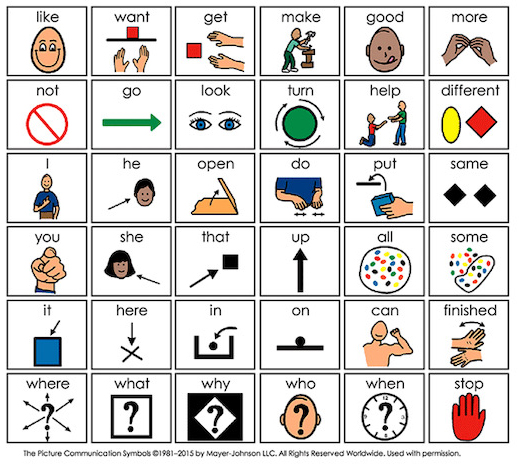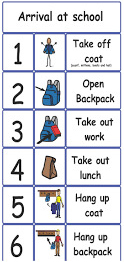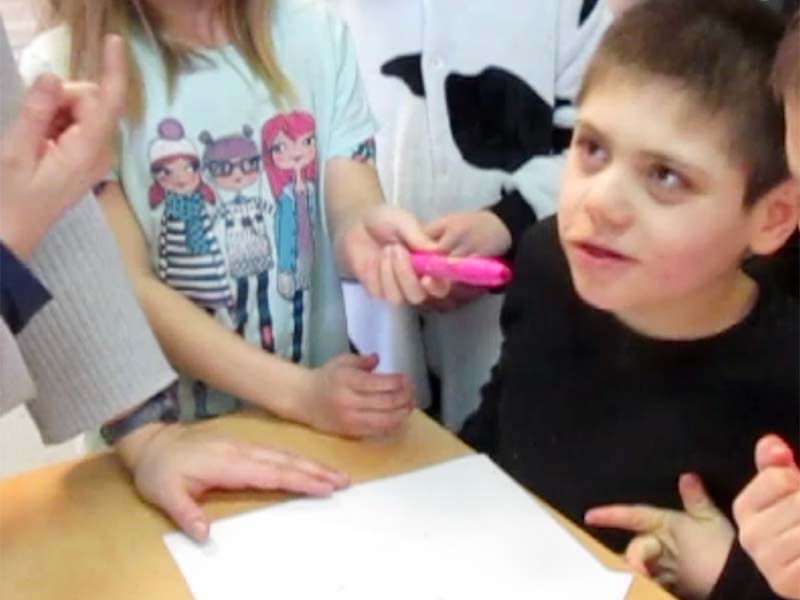Classroom Visuals
Adding visual supports, such as daily schedules with photographs or picture symbols alongside text, can help present this important information for many students.
Individualized “shape of the day” visuals on their desks or planners help to remind students of the expectations for the day.
Other students will benefit from using a mini scheduler that focuses on what is “First” and “Next” making these concepts easier to process.
Diverse Materials
Including a wide range of literacy materials relating to a student’s school, home, and local community means everyone has access to topics and formats they are familiar with and are interested in. These may be photos of local buildings or parks, information from local museums or places of interest, menus from local restaurants, or flyers from stores. All add to the richness of literacy materials.
For example, one Kindergarten classroom is using branded take-out cups and menus to create a coffee shop in their literacy centre. The students use their real-life experiences and their imagination to practice purposeful literacy skills. This recognizes the meaningful role that functional literacy or ordering your large coffee has in students’ and educators’ daily lives. Of course, with older students, this type of literacy learning would take place at the local coffee shop they would ordinarily visit.
Here are some general ways students can engage with everyday literacy materials:
- Make a choice between two books
- Find objects that relate to an activity or story
- Make a choice for a field trip activity using tourist pamphlets or maps
AAC: Core and Sight Words

The inclusion of a student’s AAC in classrooms is a good example of how to make an inclusive, literacy-rich environment. One AAC system that is frequently a part of the literacy environment in the classroom is a Core Vocabulary Board.
A core vocabulary board, or core words, is an AAC tool that has picture symbols of high frequency words that we use daily. Students with complex needs learn best when these words are taught in context in their environment, which includes literacy. Reading with students gives them opportunities to learn sight words, as many are also core words.
Some of these core and sight words are: I, me, you, help, want, play, look, go, in, see, where, what, eat, yes, no, up, like, not, here, this.
It’s important to teach these sight and core words as they form the building blocks of communication. When reading books, you can use core words in shared reading and also work to build print awareness by:
- Talking about the story, making comments, and connecting the story to the student’s experiences using core words or AAC
- Asking questions using core words or AAC
- Sharing their enjoyment by smiling, looking, making eye-contact or using core words
- Looking at or pointing to text or letters
- Looking at or pointing to sight words on the page
- Looking at or pointing to core words to say “turn the page,” “more,” or “finished”
Increase the Range of Literacy Materials
Using a variety of literacy materials gives students multiple ways to participate in classroom activities. This could mean finding alternative materials for students with complex needs.
Students with cortical visual impairment (CVI) or low vision can benefit from large print books or highlighting portions of the book for easier access to the information. They may also benefit from audiobooks or books from Google Read&Write to support their access to literacy. Students with a hearing loss can benefit from adding signs for key words, or from a service such as closed captioning. Adding additional concrete information can help to strengthen their understanding of visual literacies, such as when viewing videos or looking at photos.
Elementary students can explore independent and shared reading such as picture books, the levelled books from PM Reading and digital options such as Raz-Kids or Epic Books, to broaden their access and engage their interest. As students move into intermediate or secondary grades, use graphic novels, wordless books, and add magazines. This makes sure that chronological age-respectful materials remain the focus.
The following short video demonstrates how a teacher can support literacy. It shows how a student discovers novel ways they can use technology to increase their engagement with the words in the book.
Collaboration with Team
Collaborating with families and considering the local community is a way to ensure these literacy materials reflect social and cultural themes relating to the student’s home.
CCollaborating with others on the student’s team can ensure that literacy materials include issues of disability and diversity. For example, the ELL teacher might suggest adding literacy materials available in Arabic or Mandarin. The speech and language pathologist might suggest a book about children who use AAC.
Team collaboration is also important to ensure the student can access the literacy materials. Occupational therapists and physical therapists can assist with positioning strategies for the student’s body, and set-up of the environment to access the materials most optimally. Speech language pathologists can assist with the AAC device and any vocabulary that may be required. Teachers of students with visual impairments (TSVIs) and teachers of the deaf and hard of hearing (TDHH) can ensure the appropriate materials and equipment is available.



